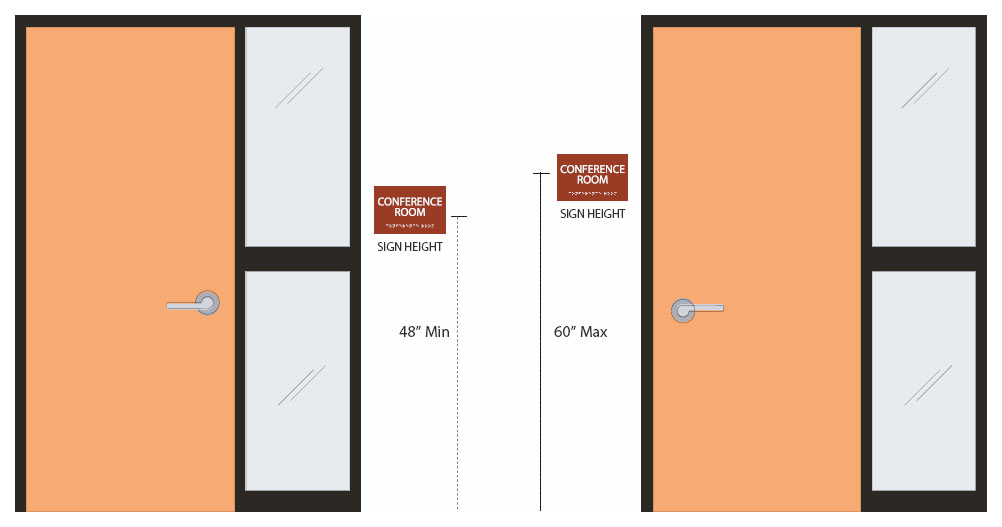Discover the Significance of ADA Signs in Public Spaces
Discovering the Trick Attributes of ADA Signs for Boosted Ease Of Access
In the world of accessibility, ADA signs serve as quiet yet effective allies, making sure that spaces are navigable and comprehensive for individuals with impairments. By integrating Braille and tactile components, these signs damage barriers for the aesthetically impaired, while high-contrast color plans and clear fonts provide to diverse visual demands.
Importance of ADA Conformity
Making sure compliance with the Americans with Disabilities Act (ADA) is crucial for promoting inclusivity and equal access in public spaces and workplaces. The ADA, established in 1990, mandates that all public centers, companies, and transportation solutions accommodate people with handicaps, guaranteeing they take pleasure in the very same legal rights and chances as others. Conformity with ADA requirements not just satisfies lawful obligations but likewise boosts an organization's online reputation by demonstrating its commitment to variety and inclusivity.
One of the crucial elements of ADA compliance is the execution of accessible signs. ADA indicators are designed to make sure that individuals with handicaps can conveniently navigate via buildings and spaces. These indications must adhere to details guidelines relating to size, font, shade comparison, and positioning to assure presence and readability for all. Correctly applied ADA signs helps get rid of obstacles that people with specials needs typically run into, consequently promoting their freedom and confidence (ADA Signs).
Additionally, sticking to ADA policies can reduce the danger of legal repercussions and potential penalties. Organizations that stop working to abide with ADA guidelines may encounter charges or suits, which can be both damaging and economically troublesome to their public photo. Hence, ADA compliance is indispensable to cultivating a fair setting for everyone.
Braille and Tactile Aspects
The consolidation of Braille and responsive components into ADA signage symbolizes the concepts of availability and inclusivity. It is commonly put beneath the matching message on signs to ensure that individuals can access the details without aesthetic help.
Tactile elements prolong beyond Braille and include increased characters and symbols. These components are developed to be noticeable by touch, enabling individuals to recognize space numbers, bathrooms, departures, and other crucial locations. The ADA sets specific guidelines pertaining to the size, spacing, and positioning of these tactile aspects to enhance readability and guarantee consistency across various environments.

High-Contrast Color Pattern
High-contrast color schemes play a pivotal duty in enhancing the presence and readability of ADA signs for people with visual disabilities. These systems are vital as they make best use of the distinction in light reflectance in between text and background, guaranteeing that indications are easily discernible, even from a distance. The Americans with Disabilities Act (ADA) mandates making use of specific shade contrasts to fit those with restricted vision, making it an essential facet of compliance.
The effectiveness of high-contrast colors exists in their capability to stand apart in numerous lights conditions, including poorly lit environments and locations with glare. Generally, dark message on a light history or light text on a dark background is used to accomplish optimum comparison. As an click for source example, black text on a white or yellow history supplies a stark aesthetic difference that aids in quick recognition and comprehension.

Legible Fonts and Text Size
When thinking about the layout of ADA signage, the selection of readable fonts and appropriate text size can not be overstated. These components are essential for guaranteeing that indications are accessible to people with visual impairments. The Americans with Disabilities Act (ADA) mandates that fonts need to be not italic and sans-serif, oblique, script, very attractive, or of unusual type. These demands assist ensure that the text is conveniently understandable from a distance and that the characters are appreciable to diverse audiences.
According to ADA guidelines, the minimum message elevation must be 5/8 inch, and it ought to raise proportionally with read the full info here checking out range. Uniformity in text size contributes to a cohesive visual experience, aiding individuals in navigating environments effectively.
In addition, spacing in between letters and lines is important to readability. Sufficient spacing protects against personalities from appearing crowded, boosting readability. By sticking to these requirements, designers can dramatically boost accessibility, making sure that signage offers its designated function for all people, no matter their visual capacities.
Effective Placement Methods
Strategic placement of ADA signs is vital for making best use of accessibility and guaranteeing compliance with legal criteria. ADA guidelines specify that signs need to be placed at a height between 48 to 60 inches from the ground to guarantee they are within the line of view for both standing and seated individuals.
Additionally, indicators should be positioned nearby to the lock side of doors to enable easy identification before entrance. Consistency in indicator placement throughout a facility boosts predictability, minimizing complication and enhancing total user experience.

Verdict
ADA signs play an important role in promoting accessibility by integrating features that address the needs of people with handicaps. These components jointly promote a comprehensive atmosphere, underscoring the importance of ADA conformity in making certain equivalent gain access to for all.
In the realm of accessibility, ADA signs offer as quiet yet effective allies, making sure that rooms are comprehensive and accessible for people with specials needs. The ADA, passed in 1990, mandates that all public facilities, companies, and transport solutions suit individuals with disabilities, guaranteeing they take pleasure in the same rights and chances as others. ADA Signs. ADA indications are created to guarantee that people with specials needs can easily browse with rooms and buildings. ADA standards state that signs must be placed at an elevation between 48 to 60 inches from the ground to ensure they are within the line of view for both standing and seated individuals.ADA indicators play an important function in promoting availability by integrating functions that address the requirements of individuals with impairments